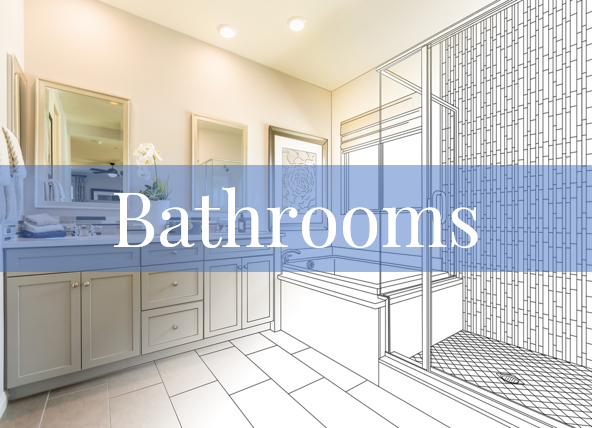Renovation Mistakes to Avoid During Your Next Project
/You’re anxious to get started on your renovation! You’ve been looking through every design magazine imaginable and watching every home improvement show on TV. You think you now know everything there is to know about renovations, but do you? In Part 2 of our look at mistakes homeowners make when renovating, we explore seven more common mistakes you can avoid when doing home renovations.
Prefer to listen?
1. Not knowing the timeline.
After 30 years in the home renovation industry, we’ve seen a lot! Some of our clients are exceptionally organized and know exactly what they want, when they want it done, what colour it should be painted, and even the sheen. Others are not quite as organized, and over the years, we’ve learned what we need to do to ensure projects run smoothly for our clients.
About 15 years ago, we were starting an ensuite bathroom project for our clients in Whitby. It was a relatively uncomplicated project. We were just removing the original builder-grade fixtures and replacing them with new ones. The client was super excited about the new space and even said she wanted to shop for her own tub, vanity, etc. The contract was signed, and she was added to our schedule.
About 8 weeks later, we started her project and got all of the demolition done quickly on the first day. Once the team had cleaned up and removed all of the debris, they called me because they couldn’t find the new tub, vanity, or toilet. I called the client at work and asked her where everything was. Her response was, Oh, I guess I should go out and start looking at what fixtures I want."
I was shocked and horrified that nothing was on site, yet everything had been demolished in her bathroom. Thank goodness she had two other bathrooms to use while we waited for her to start shopping.
I realized I had made a huge mistake! I never asked her if she had her fixtures purchased and on site before we started her project. That’s a mistake I have never again made. I just assumed that because she was so excited about shopping for her fixtures, she would have already purchased them and had them at home.
This is a mistake we used to see a lot. We now ensure that our clients know the date by which we need them to purchase fixtures, select paint colours, finalize designs on vanities or kitchen cupboards, etc. Knowing the timeline of when you need to have decisions made or items purchased will ensure you won’t feel under the gun to make an important decision or purchase you might regret later.
2. Underestimating psychological stressors.
Doing a renovation can be stressful for a number of reasons. No matter how much we plan with our clients, we always see some element of stress, and being prepared for that stress can help along the way.
We have been working with a client to plan her kitchen renovation. Everything about the project has been very smooth. She loved the design I came up with; the price came within her budget; and they both even loved the suggestions I made for a few additional storage options within the kitchen.
Now came the fun part: picking out the style of the doors, colours, flooring, backsplash tile, and countertops. This is when the nightmare started! The husband and wife couldn’t agree on a single thing! Everything she loved, he hated, and vice versa.
This caused immense stress because the couple never discussed together what they envisioned for the kitchen. He initially told her that whatever she wanted was fine with him, but apparently it wasn’t. I sat down with them, listened to what each of them wanted in the final look, and was able to offer suggestions for compromises that everyone could love. This saved the day, and perhaps their marriage! It made me realize how important it is for couples to openly discuss what they truly like in design, even if one of them says it doesn’t really matter.
3. Skimping on quality
I understand that there are budgets, but there are certain areas where you don’t want to skimp on quality. Things you touch every day, like door hardware, doors, faucets, appliances, and kitchen cabinets, should be of the highest quality you can afford. The tactile experience sends a daily reminder to you and your guests about the solidity and quality of your home.
4. Splurging where you should save
On the flip side, don’t overspend on everything! There are areas where you can easily save, so you can splurge elsewhere. For example, you could save a bit of money by purchasing a mid-range sofa for your newly renovated living room and dressing it up with some nice throw pillows. Purchase a low-end dining room table and put your money into a splashy light fixture as the focal point. Pick and choose where to spend your money wisely!
5. Not knowing measurements
We have seen this so many times! You finish a basement with a bedroom, bathroom, and recreation area. You’ve purchased this fabulous sectional, which will look great in the new space! But you forgot to measure if it would fit down the stairs! Now you’re stuck with this great sofa that you can’t get into the basement!
This exact scenario happened to one of our clients. They called us in a panic as the custom-made couch was being delivered, and they needed us to come immediately to demolish part of a wall so it would fit into the basement. They not only had to pay for the emergency call to get us to demolish, but then they had to pay for us to put it all back together again, put new drywall up, and repaint. That was one expensive sofa!
Make sure that before you purchase any furniture or appliances, you measure them to see if they will fit. When doing a kitchen renovation, make sure you pick out your appliances prior to the cabinets being made, and don’t change your mind on the size of the appliance after production has started without telling your contractor about it!
That scenario happened to a client a few years ago. We had finalized all of the cabinet sizes, and production was under way. We had the model numbers of the appliances she was going to purchase, and we knew all of the dimensions. When she went to the store to put the deposit on her appliances, she saw another fridge she just loved and had to have. She ordered that one instead but neglected to notice that it was a different size. As she had a small kitchen, we made the opening for a 33" fridge (including a 33" deep fridge upper), but the fridge she ended up purchasing was a 36". We were able to accommodate the new fridge, but it was an additional cost to her to have to pay for a couple of new cabinets.
An excellent suggestion for you is to print out all your specifications and/or installation instructions for any of your appliances, lighting, etc. Put them in a binder for the contractor and the subs or employees, and keep it onsite so everyone has access to these documents. Bonus tip: If you were to ever sell or rent your property, this is a valuable tool for the future owner.
6. Trying to be your own general contractor
It’s important to recognize that general contractors have invaluable experience with construction, materials, and sources. No matter how much you think you know about renovations, their years of experience can ensure a smoothly running job.
General contractors have something else to offer: accountability. Whether it’s their own employees or subcontractors they hire, a general contractor will have a relationship with the people doing the work. The employees or subs want to ensure that they keep the general contractor happy so they can continue to get lots of work from them. If you’re the one running the renovation, they know it’s just a one-off with you, and you may not have the same kind of accountability from them.
We had an experience with a client several years ago. Her renovation project was huge! Not only was she gutting almost the entire home, but she was also building an addition. She decided to be her own general contractor. We were the primary contractor and did the largest portion of the work, but she also hired separate people for the HVAC, windows, tiling, some drywall, landscaping, etc. It was a nightmare! Without the experience of knowing what should be done in what order, she was booking tradesmen to come in and do their portion of the work without realizing that other things needed to be done first. Tradesmen were getting annoyed at wasting their time coming out and not being able to work. There was one day we arrived for our work day, and there were so many different companies on site to work that we had to park 2 blocks away. It was so crowded that my team, as well as some of the other companies she hired, left after a couple hours as it was impossible to get anything done!
7. Working on too many rooms at once
Although you might be all excited to get going on your kitchen and three bathrooms all at once, it just adds to the mental stress and the financial budget. Pick one room and get everything done in that room first. Focus on the living areas first. The place where you spend the most time should really serve as the focus of your energy and investment. Most often, this is the kitchen. When the budget allows, move on to the next space.
Want to learn about 7 more mistakes homeowners make when renovating? Click here to read our first blog post in this 2 part series.
Are you planning a renovation and need some guidance on where to start and what you need to do to get the ball rolling? Click here to set up a free 15-minute phone consultation so you can ask your questions and know what you should be doing next!




























